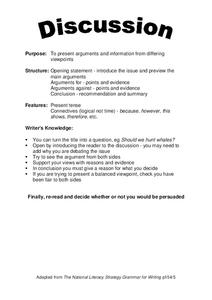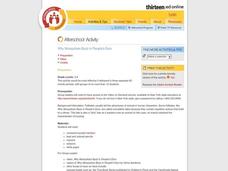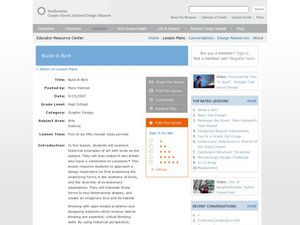Curated OER
Measuring Angles
For this measuring angles worksheet, students solve 10 problems in which angles are measured with a protractor and labeled with: acute, obtuse, right.
Curated OER
Living With the Heat: The Ring of Fire
Students investigate the planet Earth's infamous ring of fire and the life that thrives from it. In this ocean environment lesson, students investigate hydrothermal vents and how organisms thrive off their heat. Students...
Curated OER
Climate
Students study zoanthids. In this science and art lesson, students use line to create texture and how to use colors to create value. Students share their beautiful mat zoanthids with the rest of the class.
Curated OER
State of the Union Bingo
Young scholars participate in a history game. In this State of the Union lesson, students follow the provided instructions and use the provided materials to play a Bingo game based in the President's annual address to Congress.
Curated OER
The Giant Barrel Sponge
Students study barrel sponges. In this science and art lesson, students discuss what sponges are, create their own sponge, and share what they created with the rest of the class.
Curated OER
The Cleaning Station
Students study cleaning stations. For this science lesson, students make a painting of a fish known as cleaners which take dead skin off of other fish.
Curated OER
From the Gulf of Mexico to the Moons of Jupiter
Students compare deep ocean conditions to those found on the moons of Jupiter. In this Earth science instructional activity, students consider the possibilities and conditions needed to support simple life. Students examine the habitats...
Curated OER
Why Mosquitoes Buzz in People's Ears
Students appreciate African folktales, make "connections" between geography and literature, and research facts about Africa's animals and present findings through art and writing.
Walters Art Museum
The Symbolism of Allegorical Art
Introduce learners to allegorical art with four bronze sculptures by Francesco Bertos. After modeling how to recognize bias and allegory in Bertos' Africa, class groups examine the other three sculptures in the series before creating...
Julie Negrin
How to Teach Cooking to Kids
Youngsters are more likely to eat something if they've worked hard to make it! Plan a cooking class with an e-booklet from Julie Negrin, author of Easy Meals to Cook With Kids. It includes what you should consider about your...
Curated OER
What Kind of Vessel Are You?
This is a strange question; but what kind of vessel would you be and why? After examining images of a large Inca jug, the class sets to writing a creative narrative that answers that very interesting question. They start by researching...
Curated OER
Bering Sea Buffet - A Foodweb Activity
Life in the Bering Sea, food webs, and the ocean ecosystem are introduced with a map activity. The instructional activity starts as kids explore maps and images of the Bering Sea, then it kicks into high gear as they start to discuss the...
Prestwick House
Star Wars and the Hero's Journey
Is Luke Skywalker the archetype of a literary hero? Follow the path of the Hero's Journey with an engaging lesson that details the plot structure, applies it to Star Wars: A New Hope, and invites class members to choose their own...
Curated OER
Out and About-Creating Design
High schoolers demonstrate the elements of design by creating a digital photography portfolio of photos taken in and arond the scool. The edit photos using Photoshope to emphasize the element of desing in each phot.
Curated OER
Mushrooms Can Save the World
Students use mushrooms to solve problems. In this environmental lesson, students study how fungi have been used to combat environmental problems. Students design strategies that employ mushrooms to combat other environmental challenges.
Curated OER
Build-A-Bird
High schoolers create an imaginary bird. In this anatomy lesson, students analyze how artists represent birds historically, then determine the anatomical aspects that suit a bird to its habitat. Using this information, high schoolers...
Curated OER
Fly, Fly Away
High schoolers use materials from their own environment to design a kite. In this kite design lesson, students research the history of kites and obtain a formal mathematical definition of a kite. High schoolers sketch kite designs after...
Curated OER
Seating Device Design
Students research and analyze different seating devices. Once research is completed, information is compiled into a research paper including examples, images, and descriptions of seating devices. Students use research to sketch and...
Curated OER
Then, Now, and Tomorrow
Students will use this unit to investigate the past, present, and future of the architecture and plan of New York's Lower East Side. Students will research the history of the Lower East Side neighborhood in photographs used from the...
Curated OER
Caps for Sale/Color Words
Students read the book "Caps for Sale." Students model reading a sentence and using one color cap and the color word (written in its color). They match the color word (written in its color) to the correct color hat.
Curated OER
Inventing and Presenting Unit 3: Persuasive Speaking and Invention Promotion
Students write a proposal for a speech. Students prepare appropriate visuals for use in the proposed speech. Students produce one or more graphs that summarize the results from the experimentation. Students deliver an effective speech in...
Curated OER
Multimedia Book Reports
Students read a chapter book of 100-200 pages in length. They create a story map and multimedia book report. Pupils review the elements of a story map such as: characters, setting, problem, important events, solution, etc.) Students...
Curated OER
Celebrations
Second graders answer questions after listening to the the story "Celebrating Life Around the World" and verbally identify three ways in which people celebrate special occasions. They then make two verbal connections from their own...
Curated OER
Family Stories and Personal Narratives
Fourth graders read various stories in their literature books about families. Individually, they make a timeline showing the most important events in their lives. They bring in one artifact from their lives and write a paper about it...























